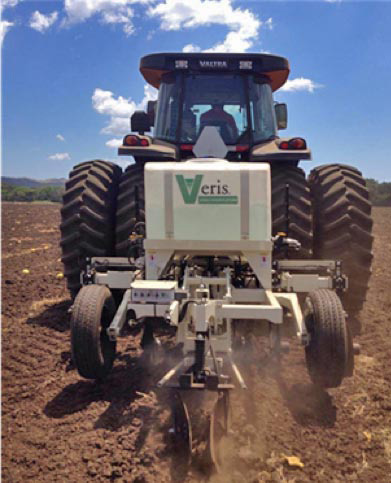Calibración y validación del equipo Veris MSP3 en dos suelos de Guanacaste, Costa Rica
DOI:
https://doi.org/10.15517/am.v30i2.33579Palabras clave:
agricultura de precisión, conductividad eléctrica, pH, reflactanciaResumen
Introducción. Es necesario implementar y validar tecnologías de agricultura de precisión (AP) en las regiones tropicales. Objetivo. El objetivo de este estudio fue calibrar y validar el equipo Veris MSP3 en dos terrenos distintos ubicados en la provincia de Guanacaste, Costa Rica. Materiales y métodos. Se correlacionaron los datos obtenidos por los sensores integrados en el equipo Veris MSP3 con análisis de laboratorio de muestras de suelo, y así desarrollar regresiones lineales simples o múltiples para predecir: textura del suelo, materia orgánica, nitrógeno en suelo, capacidad de intercambio catiónico total (CIC total) y pH, para obtener el modelo que mejor se adapte a cada parámetro. Resultados. Las regresiones que resultaron con los mejores modelos fueron: i) conductividad eléctrica aparente (CEa) con textura del suelo, ii) radio óptico y pendiente con materia orgánica, iii) radio óptico con N, iv) CEa con CIC total y v) pH Veris con pH en agua y KCl. El coeficiente de determinación más alto se obtuvo entre CEa y porcentaje de arena con un r2 de 0,82. El r2 para los parámetros evaluados varió de 0,28 a 0,82. Conclusión. El método de calibración utilizado obtuvo correlaciones razonablemente precisas (r2≥0,55) para las variables textura de suelo en la profundidad de 0 a 30 cm y materia orgánica. Sin embargo, para textura de suelo de 30 a 90 cm, N, CIC total y pH, se debe considerar otra metodología para la calibración, debido a que se obtuvieron correlaciones no precisas (r2≤0,55).
Descargas

Archivos adicionales
Publicado
Cómo citar
Número
Sección
Licencia
1. Política propuesta para revistas de acceso abierto
Los autores/as que publiquen en esta revista aceptan las siguientes condiciones:
- Los autores/as conservan los derechos morales de autor y ceden a la revista el derecho de la primera publicación, con el trabajo registrado con la licencia de atribución, no comercial y sin obra derivada de Creative Commons, que permite a terceros utilizar lo publicado siempre que mencionen la autoría del trabajo y a la primera publicación en esta revista, no se puede hacer uso de la obra con propósitos comerciales y no se puede utilizar las publicaciones para remezclar, transformar o crear otra obra.
- Los autores/as pueden realizar otros acuerdos contractuales independientes y adicionales para la distribución no exclusiva de la versión del artículo publicado en esta revista (p. ej., incluirlo en un repositorio institucional o publicarlo en un libro) siempre que indiquen claramente que el trabajo se publicó por primera vez en esta revista.
- Se permite y recomienda a los autores/as a publicar su trabajo en Internet (por ejemplo en páginas institucionales o personales) antes y durante el proceso de revisión y publicación, ya que puede conducir a intercambios productivos y a una mayor y más rápida difusión del trabajo publicado (vea The Effect of Open Access).























